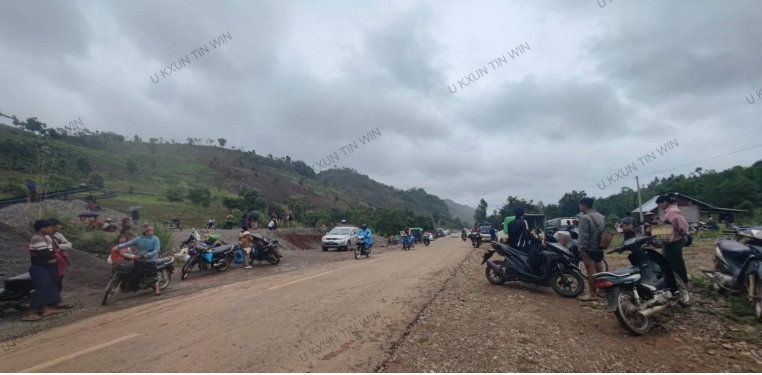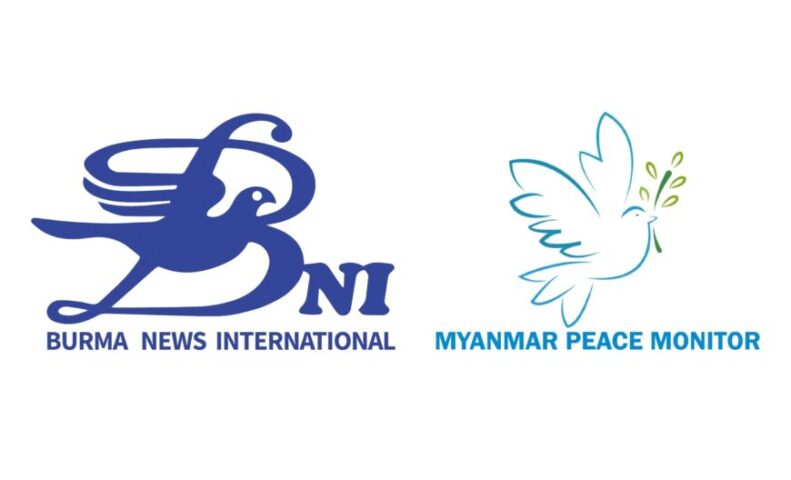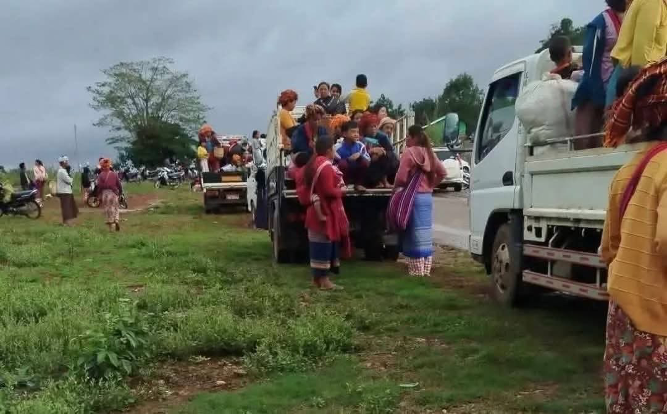An interview with Ko Chan (pseudonym), a Pinlaung local who is helping the IDPs, about the ongoing fighting in Pinlaung Township and the situation of IDPs
The military council, aiming to regain control of the Loikaw–Moebye–Pekon road—a vital supply route for Karenni (Kayah) State—is advancing into Hsi Hseng, Nyaung Shwe, and Pinlaung.
Meanwhile, Karenni resistance groups are actively fighting to prevent the military council’s forces from advancing into the strategically important gateway towns of Pekon and Moebye.
Fighting has erupted in the Pinlaung area since 17 May, when the Karenni resistance forces attacked the joint troops of the junta and the Pa-O National Organization (PNO) stationed at the foot of the pagoda west of Hsawng Pyaung village in Pinlaung Township, according to internally displaced persons (IDPs) and aid workers.
Shan News interviewed Ko Chan (pseudonym), a local from Pinlaung who is assisting internally displaced persons (IDPs), about the ongoing fighting in Pinlaung Township and the current situation of the IDPs.

Q: First, tell us about the current situation of the fighting in recent days?
A: Fighting remained intense in Hsawng Pyaung in Pinlaung Township, until yesterday (23 May). Recently, the fighting subsided slightly in Hsawng Pyaung, Looting has occurred in civilians’ homes, but it’s unclear which groups are responsible. Although villagers witnessed the incidents, they were unable to speak out. Unknown people broke into every house and took all the belongings.
Q: Which troops are stationed in Hsawng Pyaung village, and what is the cause of the fighting there?
A: There is a military council checkpoint in Hsawng Pyaung village where soldiers are stationed. So far, there have been three clashes in that area alone. Due to the ongoing fighting, the entire village is now fleeing. Hsawng Pyaung is a large village with nearly 1,000 households and an estimated population of over 4,000. The IDPs are urgently seeking shelter in nearby villages, but it is uncertain if they will be able to return home. Those displaced since the fighting began on 17 May have yet to return, and there are reports of properties being stolen and taken away.
Q: Where are the displaced people who fled the fighting taking shelter?
A: Most of the displaced people are staying primarily in Pinhkin village, Pinlaung Township. Some have taken refuge in Pinlaung town, while others are staying with relatives. Those who cannot afford the expenses are seeking shelter in nearby villages. A social organization is assisting IDPs in finding shelter.
Recently, there are no longer any IDP camps in Pinlaung accepting new arrivals, leaving the newly displaced in a difficult situation. They urgently need shelter, bamboo, and food. Some people had to flee as early as 5 a.m., before anyone was awake, with no time to prepare or pack belongings. Many had to escape on foot, especially those without motorbikes or cars, who had no choice but to run.
Q: Now that the rainy season has arrived, what are the displaced people’s most urgent needs?
A: They mainly need jackets and blankets. Many of those who fled on foot were unable to bring anything with them. Now that the rainy season has arrived, the situation is more challenging. Pinlaung receives more rainfall than many other regions and is also relatively cool.
Q: Now that the people have been displaced for the third time, what do you want to say about the current fighting?
A: IDPs primarily need food, shelter, and bamboo—these are the top priorities. Other items are less urgent. The essentials they require most are rice, cooking oil, salt, and materials like bamboo to build temporary shelters.
Q: With no dedicated camps currently set up for displaced people in Pinlaung, what are the long-term concerns for the IDPs?
A: There are certainly concerns. Lately, there have been growing rumors that the fighting could reach Pinlaung town itself, which is something we need to be very cautious about. People here in Pinlaung are in a vulnerable situation, and there’s real cause for concern. I believe the conflict is likely to continue for quite some time. The fighting remains intense, and unknown people are moving their belongings out of affected areas. Some displaced residents are worried about their abandoned homes—they return briefly, just to check from a distance. Their possessions are being transported by vehicles, and many fear that if this situation drags on, their basic survival will be at risk.
Q: Is anyone currently providing assistance to the displaced civilians?
A: There is only one local charity organization currently able to provide direct assistance. Unlike at the beginning of the conflict, no other groups are coming to help the displaced civilians. The area is difficult to access. While many organizations want to come in person, the situation on the ground makes it nearly impossible. There are numerous military checkpoints along the way, and with various armed groups operating in the area, restrictions have increased. Local residents can usually pass without trouble, but when outsiders accompany them, it often leads to complications. Once problems arise, there’s no one who can intervene. That’s why many donors and aid groups have stopped coming.
Q: If there’s anything I forgot to ask, please feel free to add it.
A: Currently, there are people trapped in Banmauk village, Pekon Township. Some have chosen not to flee, preferring to stay rather than risk being caught in the crossfire. Several roads and areas are blocked, though it’s unclear whether the blockades were set up by junta forces or resistance groups. As a result, people are not being allowed to leave. Some want to flee but are unable to. The Union Highway—connecting Loikaw, Moebye, Hpruso, and Pinlaung—is mostly blocked. Even now, fighting continues with both heavy and small arms being used. There is growing concern for those who remain trapped and unable to escape.
Q: Thank you very much for taking the time to reply.
A: Yes, thank You.
Sent by Shan News

